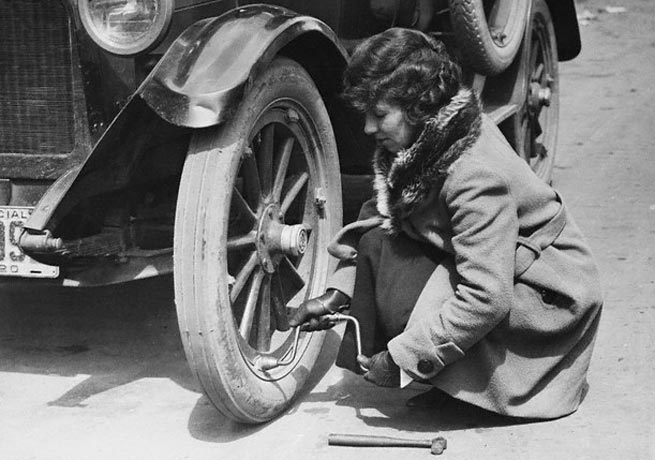Practically every woman driver knows what to do when a fellow motorist starts waving at her frantically, pointing to one of her tyres. Keeping her wits about her, she carefully pulls up at the nearest shoulder and phones her husband / boyfriend / best male friend. Then she tries her best to look interested during the whole tiresome procedure.
Well, since the he who changed my flat tyre a few days ago is still going on about it, I made a decision to take the matter into my own hands the next time things go whoosh. To that end, I have armed myself with theoretical know-how, which I am happy to share with you.

So, everyone (and ladies especially), here’s how to deal with a flat tyre:
- Be prepared. Have all the tools you need: car jack, lug wrench, wheel choc (a piece of wood will do), car manual and working gloves. Oh, also make sure there’s always a spare tyre in your boot. (If you are missing any of the essientials, find them in the bidorbuy car parts section.)
- Learn to recognise the symptoms of a flat tyre (there may not always be fellow motorists around to wave at you frantically). If your car develops strange vibrations and starts wobbling, the probable cause is a flat tyre.
- Find a level spot away from the traffic and park. Place an automatic car in the park position and a manual in reverse position. Apply the hand brake, remove the key from the ignition and put it in your pocket or handbag to avoid accidentally locking yourself out of your own car.
- Position the red triangle behind the car and / or turn on your hazard lights.
- Place the wheel choc behind the tyre that’s diagonally opposite to the flat one. So, if your right rear tyre is flat, the block goes behind the front left tyre.
- Grab your lug wrench and loosen all lug nuts on your flat tyre by turning them counter-clockwise (to the left), without removing them. (If your tyres have a hubcap and / or trim caps, remove those first.) You need to loosen the nuts in a specific sequence (see the diagram).

- Check your car’ manual to see where to position the car jack. Every model has different jacking points, and doing it wrong can damage your car’s body.
- Place the car jack beneath the car and start cranking slowly and steadily to raise the vehicle so that the tyre is just touching the ground.
- Remove the lug nuts from the wheel and place them in a safe spot.
- Raise the vehicle a little more, until the wheel clears the ground.
- Remove the flat tyre by pulling it straight toward you and lay it flat on the ground (you don’t want it to roll away). Some well-versed flat tyre changers say it’s best to place the removed tyre under the car, just in case.
- Take your spare tyre and line up the lugs with the holes in the wheel.
- Slide the spare on.
- Take lug nuts and tighten them by hand as hard as you can.
- Lower the car and tighten the lug nuts with your lug wrench in the pattern you used for taking them off. When you come to the point when you can’t turn the wrench, position it horizontally and stand on the free end to tighten the nuts some more.
Remember, you are now driving without a spare tyre – so, fix the flat or get a new tyre as soon as you can.
Those who have practiced the steps above say that the level of difficulty is low and that the time required is about 30 minutes. If it takes you much longer than that, you may want to reach for the phone…









